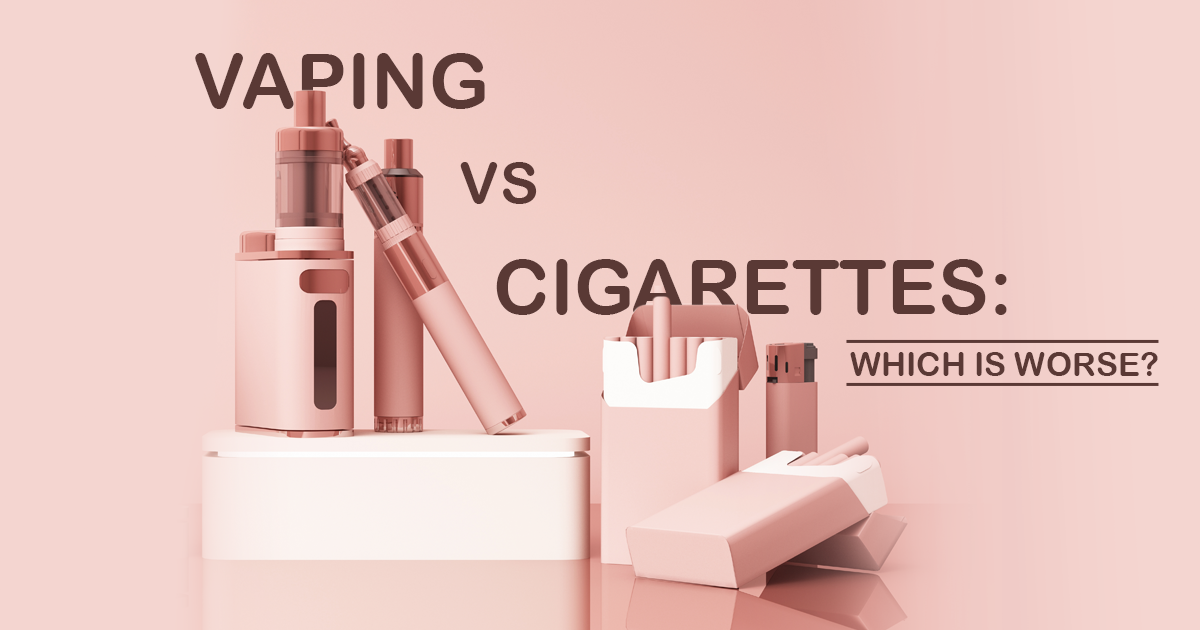In theory, when we compare vaping vs. cigarettes, neither is necessarily ideal for health. However, we live in the real world, where things often aren’t ideal.
In comparing vaping and cigarettes, if you’re going to do one or the other, vaping is considered a safer option. That doesn’t mean it’s not without risks, though, which are important to understand.
A few years ago, there was growing controversy about vaping in the United States because so many teens were picking it up. Vaping can be a better option compared to a tobacco product.
On the other hand, teens starting to vape when they didn’t previously use cigarettes is not a good idea.
What is Vaping?
When you vape, you breathe in an e-cigarette aerosol. The e-cigarette aerosol has chemicals that include flavoring and nicotine. You might use electronic cigarettes or another type of device for vaping, like a vape pen.
When someone vapes, they breathe in the vapor an electronic device creates. Electronic nicotine delivery systems are battery-powered with a heating element. These devices come with a liquid-filled cartridge with nicotine and flavoring and chemicals. The liquid heats to a vapor. The person using the device inhales the vapor, thus vaping.
Juul was initially the most popular type of e-cigarette. The company faces significant pushback from opponents who feel they specifically targeted teens and young people in their marketing. The Juul devices look like flash drives. They’re very small like USB flash drives. You can charge them in a USB port.
They make less smoke than other e-cigarettes and traditional cigarette smoking, so users can be discrete. Juul pods have the same nicotine levels as an entire pack of cigarettes. These high levels make a nicotine addiction very likely. Nicotine is already one of the most addictive substances available.
Most e-cigarettes do contain nicotine like a conventional cigarette, but not all.
Benefits of Vaping vs. Smoking Cigarettes
If you’re already a smoker and use cigarettes, vaping can be a safer alternative. There are a few reasons it can be better to vape than use cigarettes:
- With e-cigarette use, the tank systems warm the liquid nicotine and other ingredients during the heating process, creating an aerosol. Regular tobacco cigarettes have an average of 7,000 chemicals. Many of these chemicals are toxic, harmful substances. While we don’t always know exactly what chemicals are in e-cigarettes, we do know they likely expose you to fewer toxins and cancer-causing chemicals than cigarettes.
- As far as we know right now, the effects of vaping don’t directly contribute to cancers, unlike tobacco cigarettes. There’s a big caveat with this, though. Vaping is relatively new, and we don’t necessarily know what the long-term health effects could end up being from the various harmful chemicals. We have to remember it took a long time to understand more about the implications of the sale of tobacco products and the harmful effects on human health from cigarettes and cigarette smoke. It could be years before we know more about the potential health risks of e-cigarette vapor from current and future studies.
- When you use a vaping device, they don’t produce carbon monoxide or tar, which are the most toxic substances in regular cigarettes, creating the majority of the health risks.
Many people don’t realize that while nicotine is an addictive substance, it’s not necessarily the most harmful part of smoking or vaping. Nicotine is in e-cigarettes, but it has few known adverse effects. Nicotine replacement therapy is a long-used way to help people quit smoking traditional cigarettes and is largely a safe treatment.
For children and teens, nicotine can be a different situation. Nicotine vaping can slow brain development in babies, children, and teens.
The primary harm of smoking comes from the many other toxic chemicals in a cigarette, of which there is a reduction in vape products.
We also don’t currently have any evidence vaping harms the people around you. On the other hand, secondhand smoke can be very dangerous to people’s health.
Smoking’s known harmful health effects include:
- Organ damage
- It causes 90% of all lung cancer deaths and around 80% of COPD deaths
- Contributes to more than 480,000 total deaths in the U.S. each year
- Long-term effects include general inflammation, reduced sperm count, severe lung disease, and impaired immune function
- Higher risk of cardiovascular disease and general cardiovascular health problems according to the American Heart Association
Vaping has a shorter list of side effects but may still damage the lungs, weaken the immune system and release free radicals into your body.
According to the American Lung Association and the Truth Initiative, other general risks of vaping can include coughing and breathing difficulties.

The Impact of Vaping On the Developing Brain
There are real worries about vaping, not necessarily among current adult smokers but among young people. For decades, smoking rates have been declining significantly in the United States Many current smokers were using vaping to cut down on their use of traditional cigarettes or quit altogether. As a smoking cessation tool, vaping can be effective.
However, the declines in teen smoking have been reversed by vaping, which is a worrying trend.
Teens who never smoked traditional cigarettes now use these heated tobacco products. Youth e-cigarette use continues to rise. There are risks of vaping itself on the developing brain, but the habit increases their risk of moving on to cigarettes or other types of smokeless tobacco.
- Kids’ developing brains are more susceptible to the risk for addiction.
- Nicotine is highly addictive—more so even than alcohol, heroin, and cocaine.
- Some types of e-cigarettes have very high nicotine levels.
- When a developing brain sees exposure to high nicotine levels, it can contribute to addiction, problems with impulse control, and mood disorders.
- There are also negative effects of nicotine on the prefrontal cortex. The prefrontal cortex is part of the brain responsible for judgment, planning, decision-making, and attention.
Unfortunately, middle and high school students have the misconception that vaping is entirely harmless. Many of the flavored e-cigarette liquids come in kid-friendly flavors and are discrete enough to hide easily.
There has also been intense criticism that Juul targeted their e-cigarette marketing to younger audiences. Some feel their marketing led to a spike in e-cigarette consumption among 12th graders and even younger people. Since then, there’s been a big push to change laws and regulations to target current e-cigarette use among young people. You could get them into counselling to help them with this disease.
Lung Injuries and Pulmonary Disease from Vaping
Several years ago, there was a string of deaths and lung health issues that researchers believe were related to vaping. The Centers for Disease Control and Prevention (CDC) says the deaths were from an e-cigarette or vaping product use-associated lung injury (EVALI).
There was a peak in emergency department visits related to vaping in August 2019. The reason that we now know there was an outbreak of lung injuries was likely because of an ingredient in vaping fluids called vitamin E acetate. Vitamin E acetate is usually in THC-containing products. THC is the psychoactive component of marijuana.
As of February 2020, there were 68 confirmed deaths.
Even so, the annual deaths from vaping vs. cigarettes are far lower.
The recommendation from the CDC is that you not use any e-cigarette products that contain THC or vitamin E acetate because of the significant public health impact.
Ingredients like propylene glycol in vaping devices can also lead to lung inflammation and damage to e-cigarette users.
The Dangers of Secondhand Smoke
One need not engage in tobacco use to be at risk for health problems related to it. Secondhand smoke is smoke released from lit cigarettes, cigars, and pipe tobacco or exhaled from the person who is smoking these items. Inhaling secondhand smoke can cause heart disease, strokes, lung cancer, respiratory infections, asthma attacks, and other ill health effects. Exposure to secondhand smoke has killed about 2,500,000 since 1964, according to the CDC. As fewer people smoke and the number of public places that allow smoking has lessened, the number of secondhand smoke cases has decreased. Smokeless tobacco choices, such as chewing tobacco, snuff, and dissolvable lozenges all contain health risks, despite the absence of smoke during their usage.
Risks of Smoking Weed and Vaping During the Coronavirus Pandemic
During this difficult time, some individuals may be smoking marijuana in an attempt to relieve anxiety and stress. However, experts are saying it is time to think twice about this habit, as it can make you more vulnerable to contracting the COVID-19 virus. Taking this opportunity to address your marijuana addiction can ultimately spare you from any damage you may do to your airways, as well as help you better identify symptoms, if you contract the COVID-19 virus.
How Weed and Vaping Are Bad for Your Lungs
Considering the current health crisis presented by the COVID-19 pandemic, it is especially a bad time to smoke or vape, since the virus attacks the lungs. It causes a degree of inflammation similar to bronchitis or cigarette smoking. If you were to become infected with the novel coronavirus and develop COVID-19, your risk of complications increases, due to the existing lung damage. Marijuana burns at a much lower temperature than a cigarette, which means you are inhaling a certain amount of unburnt plant material. This can irritate the lungs the same way that ragweed, birch, and oak pollen can affect you if you are allergic.
The same goes for vaping, considering you are damaging the cells in your respiratory system that are responsible for protecting your immune system from respiratory diseases. Patients will be more susceptible to a cough if they have a more sensitive airway. Since a dry cough is a symptom of COVID-19, any cough caused by weed or vaping can mimic that symptom and make diagnosis a lot harder.
Vaping vs. Cigarette Cost
If you buy an e-cigarette starter kit, you’ll initially pay anywhere from $40 to $100. After you buy that, the nicotine cartridges are cheaper than traditional tobacco cigarettes.
One milligram of nicotine costs around 15.7 cents if you buy traditional cigarettes. That nicotine is only 10 cents, approximately if you’re using e-cigarettes.
Vaping Vs. Cigarettes: Who is the Winner?
The overall answer as the how vaping vs. cigarettes compare is that cigarettes are more harmful than vaping, but neither is good for you.
Vaping can be a better alternative to cigarettes, but that doesn’t mean vaping is risk-free or a completely safe option. It simply means it’s a lower-risk alternative to smoking. Both are very high risk for certain groups of people, such as pregnant women and young people with developing brains.
The best way to get health benefits is to avoid or quit both habits. Electronic and conventional cigarettes can have high nicotine concentrations and potentially dangerous heavy metals and chemicals.
To learn more about addiction treatment, call 833-844-4769 and speak to a Silver Lining Recovery team member today.

